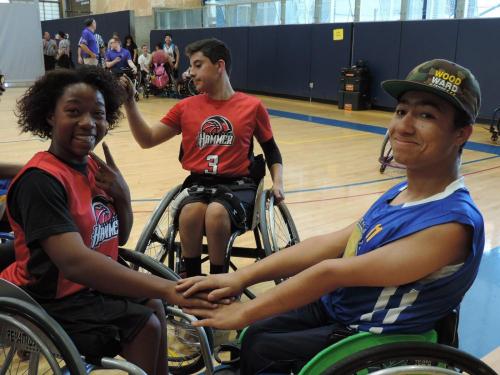
Recently I attended a junior’s wheelchair basketball tournament at Ability 360. This is a 62,000-square-foot universally designed, accessible and transit-oriented non-profit resources center serving the disability community in the Greater Phoenix, Arizona Metropolitan area. The Center is a national model for accessible design and collaborative programming. (There are at least 11 other organisations working with people with disabilities co-located in the facility). The facility is designed to bring people together with all different types of disabilities, of all ages, to encourage wellness, physical fitness and nutritional health. The 45,000-square-foot sports fitness and aquatics center is the first of its kind in the Western United States.
The tournament was organized and sponsored by Arizona Disabled Sports (ADS), an organisation that I had contacted before I left Nepal. The ADS motto is, “Let No One Sit on the Sidelines”. ADS is an NGO dedicated to providing sports and recreation opportunities for individuals with all types of disabilities. This includes but is not limited to developmental disabilities, orthopedic impairment, sensory deficit and/or neurological involvement. ADS provides year round sports training and competition. They also work with the Mesa Public Schools and the City of Mesa Parks, Recreation and Commercial facilities to provide a comprehensive program of sports and recreation to individuals with disabilities of all ages.
Although my major goal in attending the tournament was to do some recruiting for the University of Arizona Women’s Wheelchair Basketball Team, I was also interested in seeing the level of play from the 10 teams participating from a number of states throughout the US. I spoke with Tiffany Wilkinson, who is the Director, and one of only two full-time staff of ADS. Tiffany has been playing basketball for a number of years, first as an able bodied player and then due to a number of knee injuries, as a wheelchair basketball player.
It takes a tremendous amount of effort to organize a tournament. The Arizona Spinal Cord Injury Association supported this most recent effort by providing transportation to/from the airport and to Ability 360. The Ability Center also collaborates on transportation issues for many events. I was very impressed with the organisation of the tournament and how efficiently resources were used. Tiffany told me that 93% of funds from grants, fundraisers and donations, etc. go directly for sports.
I also was able to meet Gary Vanjohn who is the “father” of wheelchair basketball in Arizona. Gary is the Executive Director/Coach of the Banner Wheelchair Suns and started with disability sports in 1978 when he broke his back in a car accident. His love for basketball and other sports has led him to play, coach and inspire many athletes with a disability.
My friend Simone Galimberti of ENGAGE and I have spent a lot of time talking about creating opportunities for persons with disabilities in Nepal. This starts with youngsters who aren’t provided with many opportunities. However things don’t have to be this way because there are a number of organisations such as Nepal Spinal Cord Injury Sports Association, National Federation of the Disabled Nepal and Khagendra New Life Centre, as well as ENGAGE that are working to create more opportunities. However, the missing link seems to be solid and long-lasting collaborations.
One might look at the US and say, “they have lots of resources and therefore they can afford to build a place such as Ability 360 which specifically caters to persons with disabilities”. But the fact is, that this took years and multiple resources to bring to fruition. I have hope that Nepal will also be an example of best practices when it comes to providing opportunities for persons with disabilities but it will take cooperation.
Gary Vanjohn told me that he felt that wheelchair sports, persons with disability being out and wanting more led to the American with Disabilities Act. This created more societal inclusion. But it also works the other way, i.e. when the able bodied society realizes that we are all equal, that we should remove barriers, then people with disability, or of various ethnic backgrounds, religions and sexual orientations become part of an inclusive society. We must start doing this as children are growing up, an example of which is occurring in Arizona with children with disabilities and their ability to participate in all societal aspects. I always felt that nothing was ever impossible in Nepal and I still believe this.










Add new comment